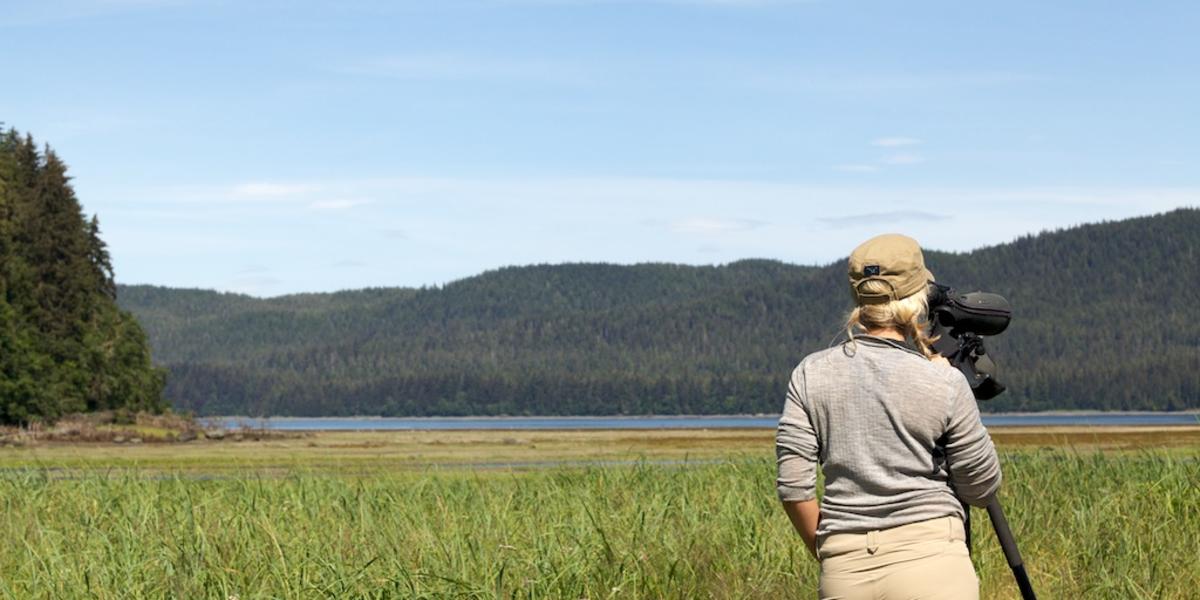

Bird-Watcher's Paradise
Southeast Alaska's rainforest is alive with the chirps and trills of more than 300 species of birds that flutter along the flyways of the state's panhandle. More than 280 species nest in Juneau. The best month to observe nesting birds is June, also the best time for listening for their songs.
Juneau's varied habitats provide great opportunities to view a wide range of bird species.
Before mating for life, Vancouver Canada geese stay with their parents up to four years. This goose is distinctive, with a brownish gray back and wings, long black neck and head, and white cheeks. It weighs up to 16 pounds.
The most common sea ducks in Juneau are scoters, oldsquaw, Barrow's goldeneye, harlequin, and buffleheads along with mallards, scaups, and mergansers.
The brilliantly feathered harlequin duck and American dipper make their home in Southeast Alaska; the American dipper builds its nests along streams and can walk underwater for short distances.
Refueling on their journey up the Pacific flyway are tundra swans, northern pintails, American golden-plovers, sandpipers, sandhill cranes, and red-necked phalaropes, with as many as 15,000 of them in Glacier Bay during the summer.
Rufous hummingbirds desert Mexico for Alaska from April to August, when they are frequent visitors to Southeast hummingbird feeders. The males are distinguished by their iridescent orange-red throat.
Of the 100,000 bald eagles in the world, about 50 percent live in Alaska. More than 10,000 breeding pairs make their home in Southeast Alaska. In Southeast, there's about one active nest for every mile of shoreline or coastline - which means you've just entered one of the densest concentrations of bald eagle nests in the world. They generally nest in old-growth timber, such as Sitka spruce and western hemlock trees, along saltwater shorelines and mainland rivers.
Regionally, Admiralty Island or the Alaska Chilkat Bald Eagle Preserve in Haines are good scenes for bald eagle sightings. Locally, the Auke Bay boat harbor is a hot spot for observing the majestic bird. Another popular place is False Outer Point on Douglas Island.
Healthy adults weigh 9 to 12 pounds, with wingspans stretching 6 to 8 feet. Female bald eagles are larger than males - a common trait of raptors. With their keen vision, the birds can spot prey up to two miles away.
When hunting for live fish, bald eagles skim the top of the water and snatch the fish in their talons. Because they can't fly with more than 4 to 6 pounds of food, they usually pounce on super-sized salmon in shallow water and drag the salmon to shore.
Nest building typically begins in April, and sites are often reused. Near the end of the month, two or three eggs are laid several days apart. The male and female take turns incubating the eggs for 35 days. Eggs must be protected from excessive heat and cold almost 24 hours a day.
Typically, just one eaglet will survive. Surviving eaglets stay in the nest for 70 to 90 days before fledging. Southeast Alaska's temperate, coastal climates mean bald eagles typically don't fly farther south for the winter.


